An anchor hooking an oil pipeline may have caused the Southern California spill that spewed more than 100,000 gallons of oil into the Pacific Ocean, the federal Pipeline and Hazardous Materials Safety Administration said in a notice to operation owner Amplify Energy.
“The pipeline has essentially been pulled like a bow string. And so at its widest point is about 105 feet away from where it was. So it is kind of an almost a semicircle,” Amplify Energy CEO Martyn Willsher said at a press conference Tuesday.
There is no confirmation of a vessel above the site of the spill, but a response team is working with other agencies to determine whether a ship was in the area, said Capt. Rebecca Ore, the commanding officer at US Coast Guard Sector Los Angeles-Long Beach.
In pictures: Oil spill in Southern California
Earlier Tuesday, authorities said a 4,000-foot section of the pipeline was displaced laterally about 105 feet and had a 13-inch split that was likely the source of the spill.
The discovery explains the likely source of a spill, widely reported Saturday, of as much as 144,000 gallons of crude oil about five miles off the coast of Huntington Beach. The spill has shut down prized beaches, damaged the environment and presented possible health hazards for local residents.
Authorities investigating the leak also sought Tuesday to clarify the timeline of when authorities and the pipeline company learned about the spill and what they did in response.
The Unified Command said the National Response Center first received a report of an unknown sheen of unknown source on Friday evening.
“These types of reports are common and in many cases, the sheen reported can be natural seepage of oil or sheen that is never located,” the Unified Command said in a press release. “NOAA satellite imagery was reported to agencies early morning reporting a possible oil anomaly.”
Crews from the California Department of Fish and Wildlife’s Office of Spill Prevention and Response went to investigate before sunrise, but conditions were foggy and the crew returned to shore, authorities said.
“The Coast Guard and Orange County Sheriff deployed at first light once fog lifted to investigate. A Coast Guard aircraft was diverted to support the investigation. On Saturday morning, the company confirmed a release of oil from a pipeline,” the Unified Command said.
The timeline confirms that California authorities were notified late Friday of reports of an oil sheen at the site of the spill, more than 12 hours before Amplify Energy Corp., the operator of the line, reported it to state and federal officials, according to documents reviewed by CNN.
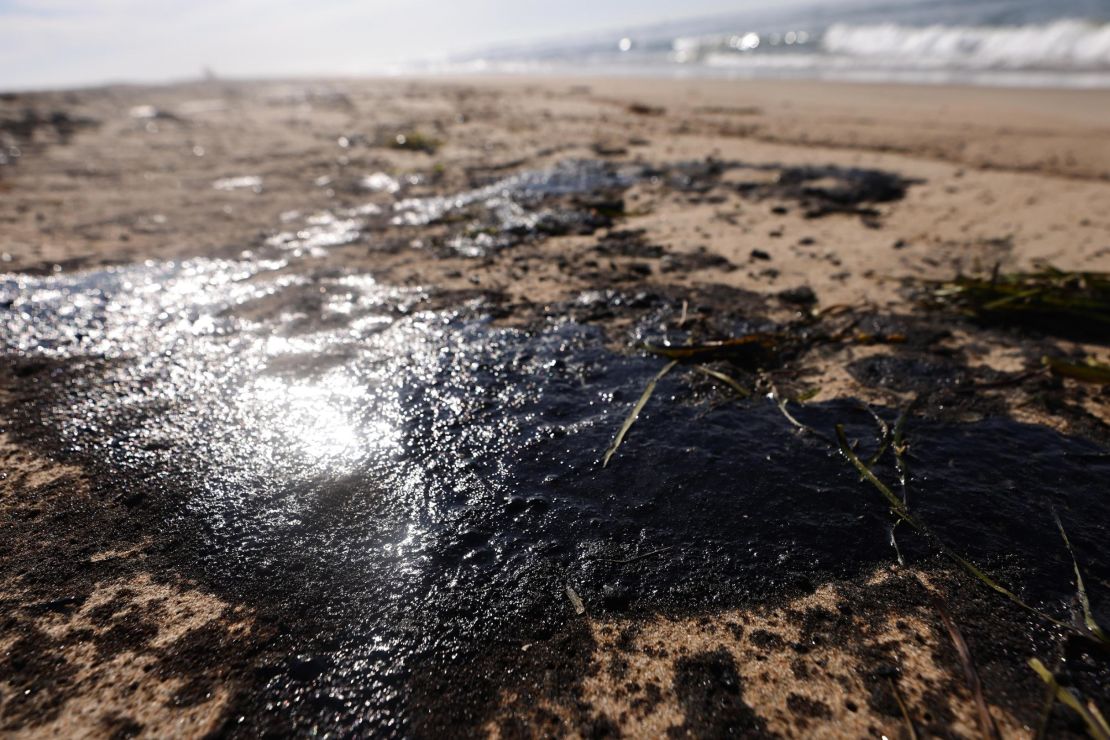
At a news conference Monday, Amplify’s Willsher said a sheen was detected by company personnel Saturday morning, not Friday night. Willsher said while there is equipment to detect the leak without visibly seeing oil spills, there were no notices of a potential leak in the line before Saturday.
The timing is important because of how many people were potentially impacted by the spill on Saturday, said Orange County Supervisor Katrina Foley.
“There were hundreds of boaters out on the Huntington Beach coast because we had an air show,” Foley said. “There were hundreds of boaters coming back and forth from Catalina to Orange County.”
In a federal “corrective action order,” Amplify Energy was directed to shut down the pipeline entirely, provide maintenance and inspection records, and complete a root cause failure analysis, among other requirements. Only then can it submit a plan to resume operations.
The Pipeline and Hazardous Materials Safety Administration wrote that the cause of the spill remains unconfirmed.
Surfer says he was caught in the spill Saturday
Nathan Avila found himself caught in the spill Saturday night when he arrived at a jetty near Newport Beach, one of his favorite surf spots.
He told CNN he saw a lifeguard speaking with other surfers, but didn’t think it had anything to do with him. Then he heard sirens and decided to get out of the water.
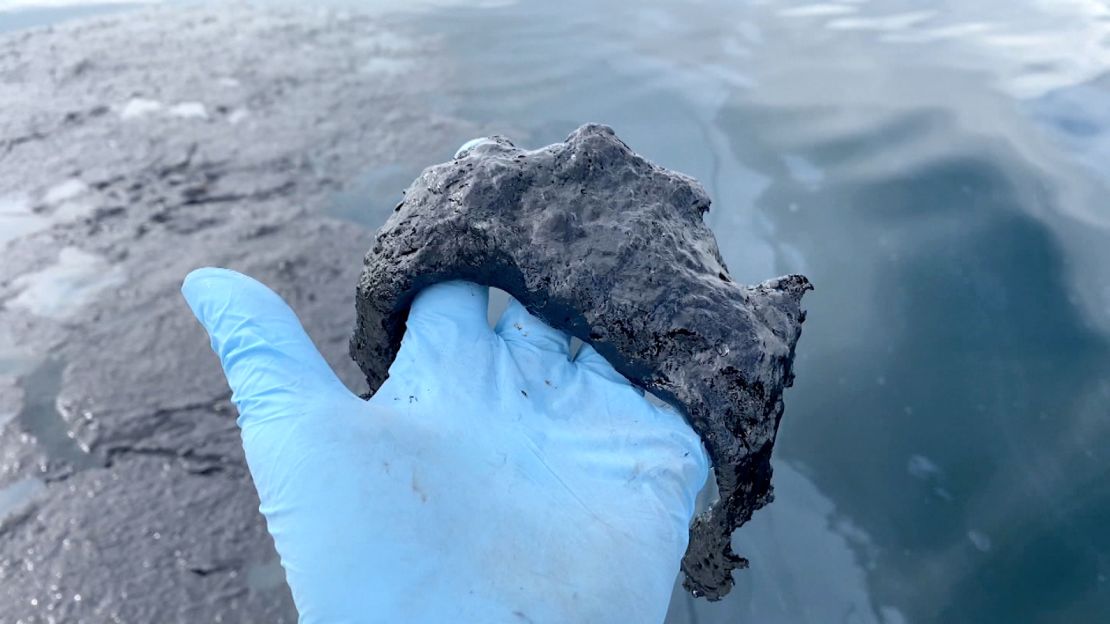
“I look down at my hand and I see oil over it, so I knew right then … this is an oil spill, this is, this is no joke,” he said.
Avila, who is from Long Beach, said he had dish soap with him to try washing the oil away, but it didn’t work.
“I was lucky enough that I was wearing a full wetsuit, so my wetsuit’s pretty much trashed, it’s like soaked into my wetsuit,” he said. “The surfboard had oil all over it. There was specs on my face, it was all over my hands, my feet, but I was really lucky to be wearing a wetsuit.”
Avila wound up going to his house and using alcohol to wash the oil off.
On Tuesday, Avila and his business partner, Elliot Lewis, ventured out into the waters of the Pacific Ocean to film the floating blobs of oil. They were eventually told to leave by the US Coast Guard.
“The part that I was most surprised on is how thick the patties of oil were,” Avila said. “You could pick them up in your hand and it was about two inches thick and just globs. And we were seeing these globs everywhere.”
Lewis told CNN the smell is what got to him.
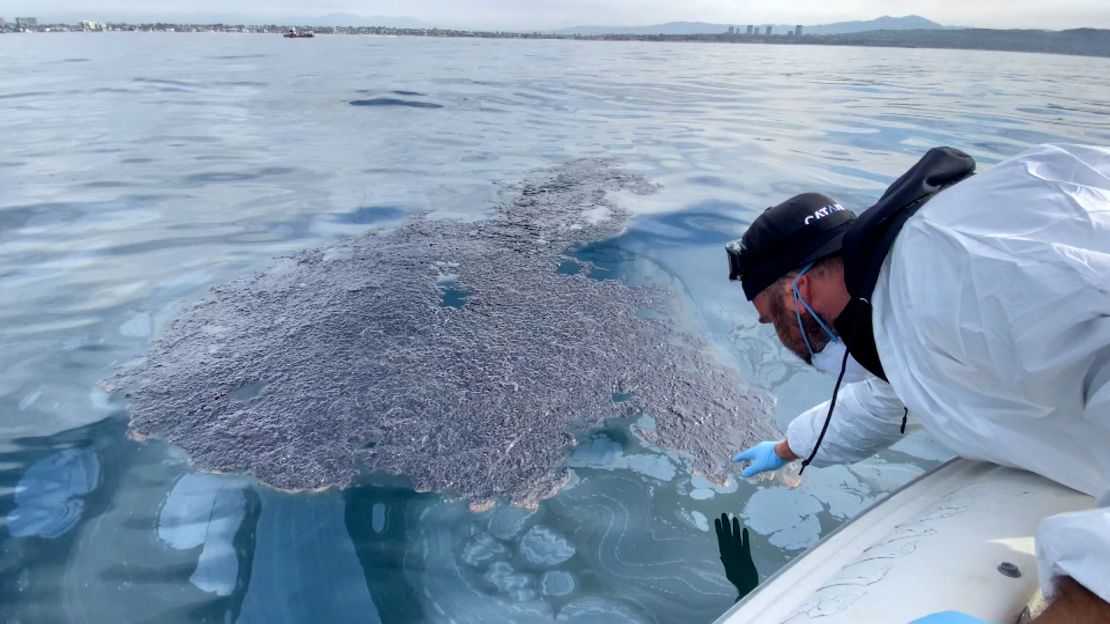
“It just smelled like death oil basically, like you were walking through a refinery and then we saw all these different patties of oil had floated to the top, some as big as a Frisbee and some five, six times greater than that and we were just right in the middle of it. It was just disaster of the worst kind,” he said.
Lewis added: “No way that an animal could survive in that water.”
Spill cleanup is underway
Huntington Beach once had a a sign reading “Surf City USA.” A new sign Monday read “Beach open, Ocean and Shore closed.”
On one beach section, workers in hazmat suits and rakes cleaned up tar balls from the spill, while beach-goers and their dogs ran between them.
And a little farther south, teams in white hazmat suits worked to protect the fragile wetland ecosystem near the mouth of the Santa Ana River – a crucial habitat for migratory birds that is now wrapped in shimmering oil ribbons.
On Monday, Gov. Gavin Newsom proclaimed a state of emergency due to the spill. “The state is moving to cut red tape and mobilize all available resources to protect public health and the environment,” he said in a statement.
The spill, which stretches from Huntington Beach to Laguna Beach, is likely to move farther south based on wind and currents, the Coast Guard’s Ore said.
The spill is just the latest such incident to hit California’s shores, including the 1969 spill of as much as 4.2 million gallons of crude oil near Santa Barbara. Locally, Huntington Beach bore the brunt of a 1990 spill of about 417,000 gallons of crude oil when an oil tanker ran over its anchor and punctured its hull.
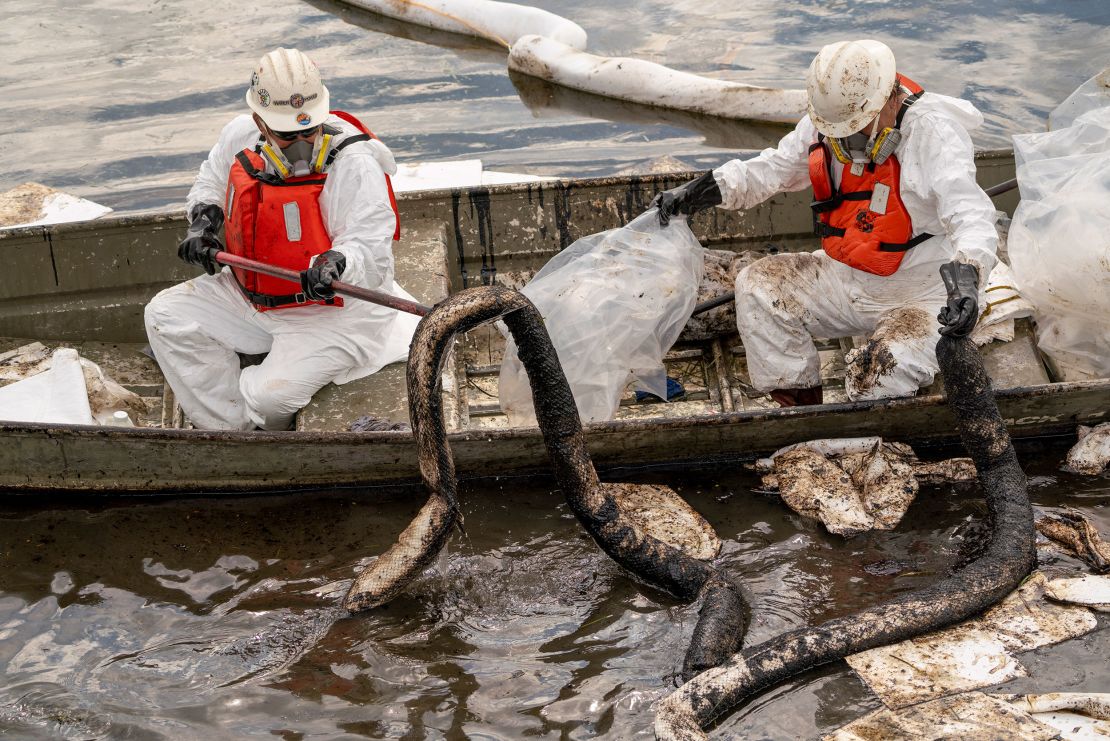
The current spill’s volume pales in comparison to the most serious oil spills in history, including the 1989 Exxon Valdez oil spill in Alaska (11 million gallons) and the 2010 Deepwater Horizon spill in the Gulf of Mexico (134 million gallons).
As of Tuesday morning, about 4,800 gallons of oil has been recovered from the water and about 11,400 feet of boom – a term for floating barriers designed to contain an oil spill – has been deployed.
Dead birds and fish have already washed ashore, according to Foley, who has been providing updates on Twitter.
“This has devastated our California coastline in Orange County, and it’s having a tremendous impact on our ecological preserves as well as our economics,” Foley told CNN. “We need answers and the public deserves answers.”
Eight birds have been recovered from the oil spill, according to OWCN, including a brown pelican that was euthanized because of a wing injury.
For some, this latest incident is a sign of a need for change to protect the environment.
“As California continues to lead the nation in phasing out fossil fuels and combating the climate crisis, this incident serves as a reminder of the enormous cost fossil fuels have on our communities,” Newsom said Monday. “Destructive offshore drilling practices sacrifice our public health, the economy, and our environment.”
Investigation into the cause
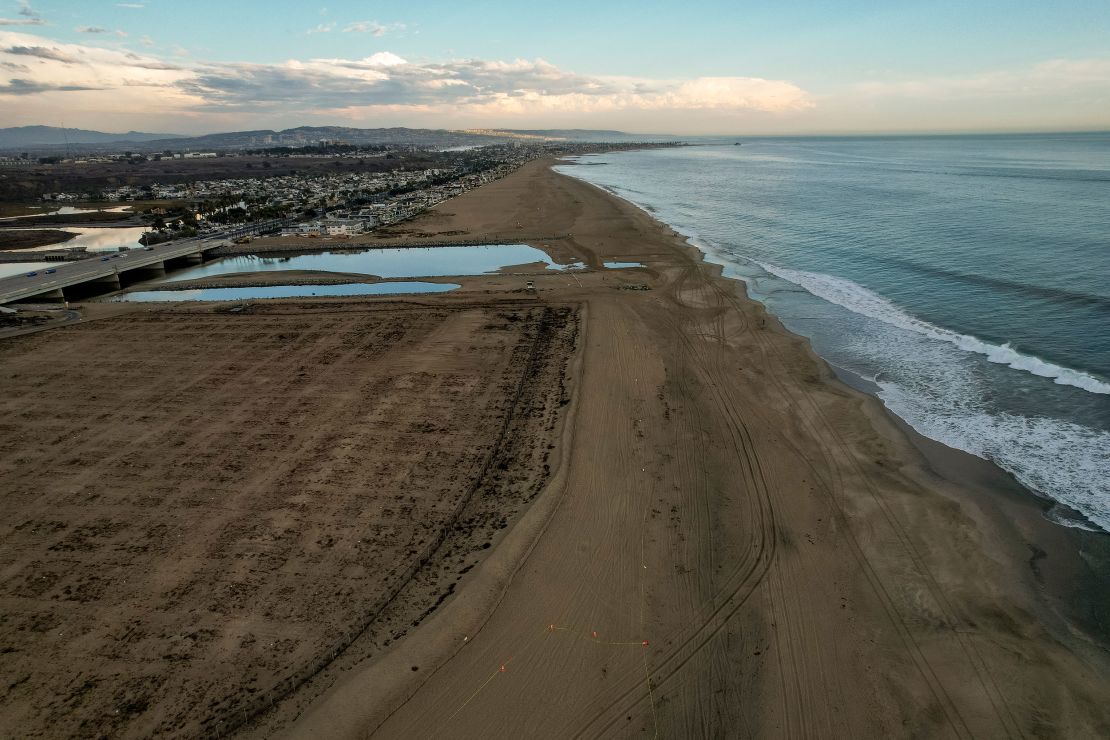
Willsher, the Amplify executive, apologized Tuesday for the spill and vowed to clean the area up.
“This is a terrible tragedy and we’re extremely sorry this happened, obviously the cause of this still needs to be investigated. But regardless of the cause, we’re going to do everything we can to make things right for all those impacted areas and individuals, as quickly as we can,” Willsher said.
Amplify is a small, Houston-based company with 222 employees as of the end of 2018, the last time it reported its staff size in a company filing. Its most recent financial report shows sales of $153 million, with year-to-date losses of $54.4 million through the end of June.
Amplify’s pipeline was due for an inspection at the end of this month, Gov. Newsom said Tuesday.
An inspection is done on the pipeline every two years. An internal check was completed in October 2019 and an external inspection was done in April 2020.
While there were no issues with the pipeline during the previous inspections, Newsom said they’re going back to the details of those reports.
The federal Bureau of Safety and Environmental Enforcement was assisting in Coast Guard-led response to the oil spill, the agency told CNN. Its role was to assist “in identifying the location and source of any spills and provide technical assistance to the Unified Command in stopping the spillage,” it said Sunday in a statement.
CORRECTION: An earlier version of this story misidentified where Amplify’s CEO made his remarks on when the oil sheen was detected. It was during a news conference.
CNN’s Stella Chan, Susannah Cullinane, Claudia Dominguez, Chris Isidore, Julia Jones, Eric Levenson, Sara Sidner, Sarah Moon, Alta Spells, Joe Sutton, Sonnet Swire, Camila Bernal and Anna-Maja Rappard contributed to this report.































































